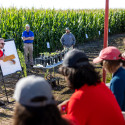Veterinary program readies abandoned pets for homes �
 In the east wing of the university’s Veterinary Medicine building, School of Veterinary Medicine third-year students (left to right) Cora Singleton, Kandie Harma and Marie Creed examine a pup brought to the school for its spay-and-neutering program. The school now has contracts with seven humane societies, including Dane, Washington, Columbia, Jefferson and Rock counties, and shelters in Watertown and Beaver Dam. Photo: Jeff Miller
|
Thursday mornings are more harried than most at the east wing of the university’s Veterinary Medicine building. It’s pick-up and drop-off day for the school’s cooperative clinic with humane shelters, and new arrivals tend to generate a buzz.
This morning, the animals of the hour are four cats from the Jefferson County Humane Society, including Georgia, Sugar, Abbey and an unnamed stray. Sugar, a young tabby, was picked up by Whitewater police earlier that week.
“She’s a juvey,” one student joked.
As the animals settle into kennels, students talk to them, calm them and learn their personality quirks. By the time the animals leave, they will have a clean bill of health and a vastly better chance at adoption.
The most important procedure will be having the pets spayed or neutered, which is a requirement for any pets that are adopted from Wisconsin humane societies.
This program began in 1992 under the guidance of former professor Eberhard Rosin, who was committed to finding an ethical and socially beneficial way to train students in core issues in veterinary care. Rosin, who died earlier this year, worked with humane societies across southern Wisconsin and with state veterinarians to establish the program.
The school now has contracts with seven humane societies, including Dane, Washington, Columbia, Jefferson and Rock counties, and shelters in Watertown and Beaver Dam.
Along with giving third- and fourth-year students essential training, the program has had some unexpected benefits. Many of the pets, for example, are adopted before they even make the trip back to the shelters.
Joanne Reuter, a third-year veterinary medicine student from rural Madison, adopted a 3-year-old dalmation named Sadie in October. Sadie was the first pet Reuter had spayed. She and her husband already have two dogs, but living on an 85-acre farm gives them some flexibility.
“That’s why my husband had a hard time saying no,” she says.
“We are very motivated to find these pets homes,” Reuter adds. “We show these pets off to other students and friends. We’re here because we love animals, and we want to see this have a happy ending.”
Ellen DeGrave-Madigan, instructional specialist in the program, says an amazing number of animals – as many as 40 percent each semester – get adopted while they’re at the school. The clinic may see about 200 shelter animals a year.
The program has become an instrumental part of the curriculum. “It’s the whole picture – they take care of these animals for a week, walk them and feed them,” she says. “They do heartworm tests, blood work, initial physical exams. We’re trying to make it a whole-clinic approach. This is what they will be doing in practice.”
Dale Bjorling, professor of veterinary surgery, says the program has been a major plus for the school’s educational mission. Spaying and neutering is one of the most common surgeries veterinarians need to perform, and practitioners in the field expect their new hires to know the ropes.
But like any invasive surgery, it’s difficult and carries many potential complications. The students work in teams of three – a primary surgeon, and assistant and an anesthesiologist – with a clinical staff member providing oversight. “The desirable thing is we can teach a large number of our students at one time. Our primary concern is for the welfare of the animals. Students show a high level of concern.”
One reason adoption rates are so high, Bjorling suspects, is that students develop an emotional bond with the pet.
The procedure is a big milestone in their training. “Students study videotapes on the procedure and they really get into it,” he says. “It’s their first surgery and it’s a major, significant event.”
The humane society representatives also speak highly of the program. Colleen Gilbreath and Theresa Grass, representatives of the Washington County and Columbia County humane shelters, say both shelters take in more than 3,000 dogs and cats a year, and only a fraction of them are spayed or neutered. Most people coming in for adoptions want that taken care of in advance because it will require up to $130 in additional costs for the adoption.
Without it, the chances of adoption are slim. Both representatives say their adoption rate is near 80 percent for the animals who come through the program – a much higher percentage than the overall shelter population.
“The pets fare real well; they come back healthy and happy,” says Gilbreath. “This program is a godsend. We will do anything to make our pets more adoptable.”
Tags: learning






